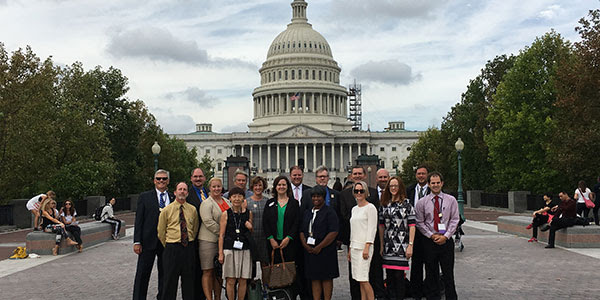- About Us
- Events & Training
- Professional Development
- Sponsorship
- Get Involved
- Resources
2016 Policy and Advocacy ConferenceBy Josh D. Peters, AICP Each fall, the Policy and Advocacy wing of APA National puts on the Policy and Advocacy Conference (PAC) in Washington, DC. As Co-Chair of APA Washington’s Legislative Committee for a decade, I’ve long had my eye on the PAC gathering in Washington D.C., which includes the annual “Planners’ Day on Capitol Hill,” a chance for the planning community to have direct interaction with our representatives in Congress and/or their staff. The experience was as memorable and educational as I had imagined. Recognizing the challenge of summarizing a full conference worth of education and events, my aim here is to share some highlights, point you to sources of additional information, and show some ways you could get involved in APA’s policy and advocacy efforts. For insights and details of what happened at PAC16, see:
For Planners’ Day on Capitol Hill, APA set us up with appointments in the Senate and House buildings, gave us instructions on how best to communicate policy objectives to our representatives in DC, and provided materials for us to leave behind following our meetings. Our main message to deliver focused on two key issues:
 I met with legislatives assistants for Senator Maria Cantwell, Senator Patty Murray, and Representative Derek Kilmer (6th District) to present our case for these programs. See the policy “leave-behind” factsheets linked above for details on APA’s positions on these issues and our specific “asks.” In my meetings, I was asked about LWCF projects and Plan4Health projects in Washington State. I was able to point to these “exemplary” LWCF projects and where one can access a summary and full list of LWCF projects in our state. I also informed Congressional staff about our current Plan4Health coalition in Pierce County. (See also this past article from The Washington Planner.) Finally, I let them know about APA’s full set of 2016 legislative priorities, as well as the Washington Chapter’s “Ten Big Ideas.” They know how to find me if they have any follow-up questions or requests for support! Speaking of getting the word out about the value of community planning, APA staff provided us with multiple ideas for recognizing National Community Planning Month (NCPM is October! #PlanningMonth) and taking advantage of social media in general to promote the planning process and planning profession. APA provides a Communications Guide to help get the word out about planning stories, ideals, and objectives. The key messages to share during NCPM include:
There is also an NCPM Resource Hub with graphics, signs, banners, media examples, and the like. In the next issue of Planning Magazine, you’ll be getting a “Brought to You by Planners” sign. Conference participants offered feedback to APA National staff, which resulted in the creation of a “Brought to You Through Planning” variation that planners may feel more comfortable sharing. There’s also a sign that says, “Imagined by Planners,” if that suits your fancy. NCPM kicks off every October with the announcement of the next round of “Great Places in America.” As I warned, I’m not able to completely describe everything that happened at PAC16. However, I can say that in my view the overarching theme of the gathering was social equity and inclusive growth. This theme ran throughout PAC16. In particular, the conference included a Daniel Burnham Forum on Big Ideas that tackled the topic head on. This Burnham Forum featured a panel that included the mayors of Kansas City and Atlanta. In the context of HUD’s Prosperity Playbook, the discussion centered on building communities of opportunity through the expansion of affordable housing and economic mobility. The question for the planning community is how we can best facilitate action that results in improvements in the lives of those who have been historically disadvantaged, by virtue of race, ethnicity, class, etc. One thing that is happening now is development of an APA policy guide on “Social Equity and Inclusive Growth.” Getting involved in that process is one of the ways you could get active with APA’s Policy and Advocacy program. Here are several ways you can get involved in APA’s Policy and Advocacy efforts:
|

